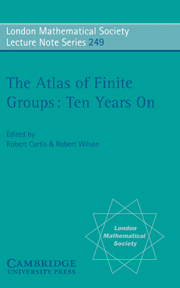Book contents
- Frontmatter
- Contents
- Introduction
- Addresses of registered participants
- Addresses of non-participating authors
- Programme of lectures
- Conference photograph and key
- Symmetric presentations and orthogonal groups
- A constructive recognition algorithm for the special linear group
- Relations in M666
- A survey of symmetric generation of sporadic simple groups
- Harish-Chandra theory, q-Schur algebras, and decomposition matrices for finite classical groups
- The Meataxe as a tool in computational group theory
- Branching rules for modular projective representations of the symmetric groups
- Characters and surfaces: a survey
- On the characterization of finite groups by characters
- Finite linear groups of small degree
- Minimal parabolic systems for the symmetric and alternating groups
- Probabilistic methods in the generation of finite simple groups
- Condensing tensor product modules
- Intersections of Sylow subgroups in finite groups
- Anatomy of the Monster: I
- An integral ‘Meat-axe’
- Finite rational matrix groups: a survey
- Chamber graphs of sporadic group geometries
- An Atlas of sporadic group representations
- Presentations of reductive Fischer groups
- A brief history of the ATLAS
A constructive recognition algorithm for the special linear group
Published online by Cambridge University Press: 19 May 2010
- Frontmatter
- Contents
- Introduction
- Addresses of registered participants
- Addresses of non-participating authors
- Programme of lectures
- Conference photograph and key
- Symmetric presentations and orthogonal groups
- A constructive recognition algorithm for the special linear group
- Relations in M666
- A survey of symmetric generation of sporadic simple groups
- Harish-Chandra theory, q-Schur algebras, and decomposition matrices for finite classical groups
- The Meataxe as a tool in computational group theory
- Branching rules for modular projective representations of the symmetric groups
- Characters and surfaces: a survey
- On the characterization of finite groups by characters
- Finite linear groups of small degree
- Minimal parabolic systems for the symmetric and alternating groups
- Probabilistic methods in the generation of finite simple groups
- Condensing tensor product modules
- Intersections of Sylow subgroups in finite groups
- Anatomy of the Monster: I
- An integral ‘Meat-axe’
- Finite rational matrix groups: a survey
- Chamber graphs of sporadic group geometries
- An Atlas of sporadic group representations
- Presentations of reductive Fischer groups
- A brief history of the ATLAS
Summary
Abstract
In the first part of this note we present an algorithm to recognise constructively the special linear group. In the second part we give timings and examples.
Introduction
It seems possible, using Aschbacher's celebrated analysis of subgroups of classical groups [5], to develop algorithms that will answer basic questions about the group G generated by a subset X of GL(d, g), for modest values of d and q, as is already possible for permutation groups. The best strategy may involve trying to recognise very large subgroups of GL(d, q) by special techniques.
In the case of permutation groups, special techniques are used to recognise the alternating and symmetric groups. This is done by making a random search for elements of a certain cycle type. If such elements are found in a primitive group, the group is known to contain the alternating group. If no such elements are found after a sufficiently long search, one proceeds with the expectation that one is dealing with a smaller group. For linear groups, the corresponding question is to determine whether or not the group in question contains a classical group.
It is possible to recognise the classical groups in a non-constructive way as described in [6], [7], and [2]. This still leaves the further problem of exhibiting an explicit isomorphism, that is to say, given that the group G = 〈X〉 contains a classical group, how can one express a given element A of G as a word in X? We call an algorithm to solve such a problem a constructive recognition algorithm.
- Type
- Chapter
- Information
- The Atlas of Finite Groups - Ten Years On , pp. 11 - 26Publisher: Cambridge University PressPrint publication year: 1998
- 5
- Cited by

